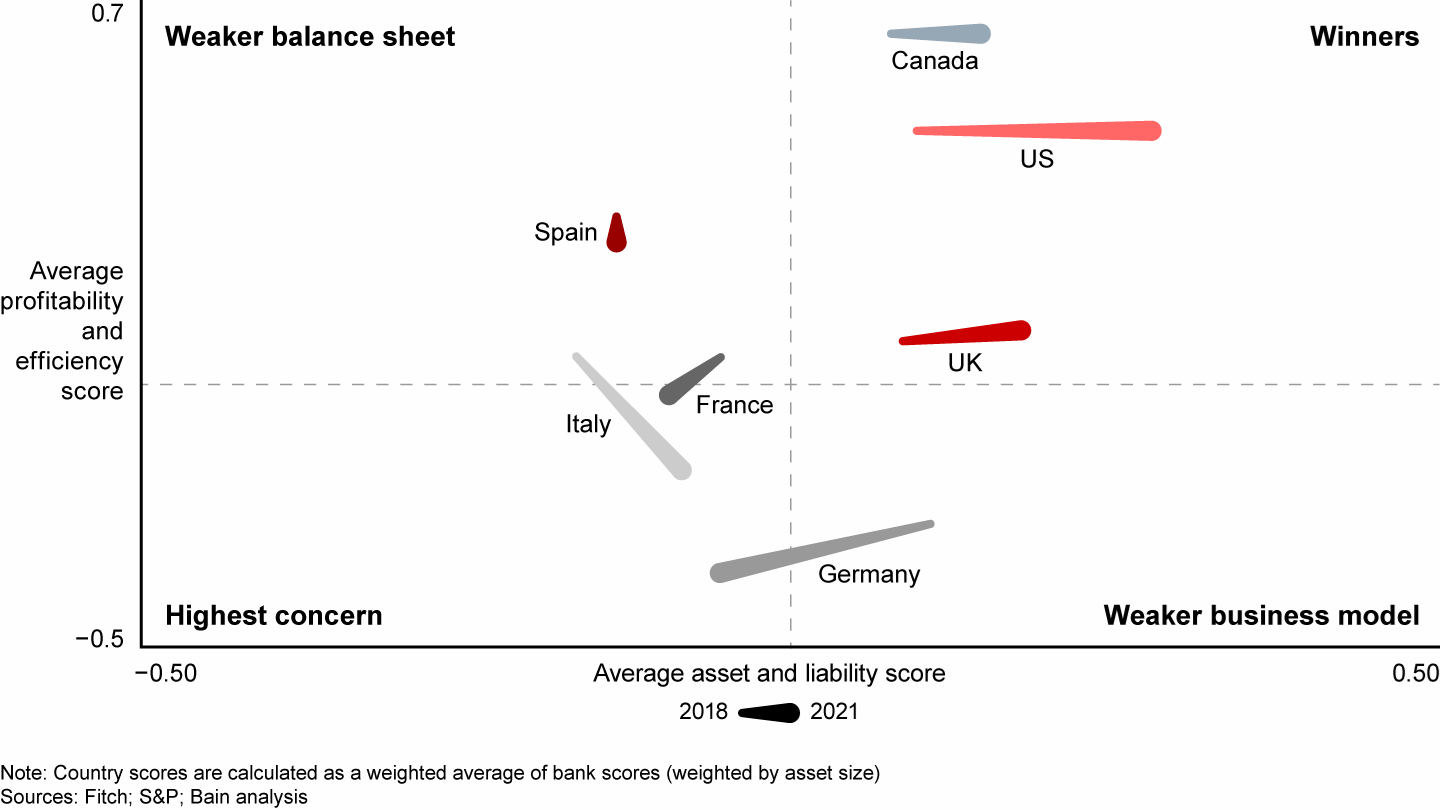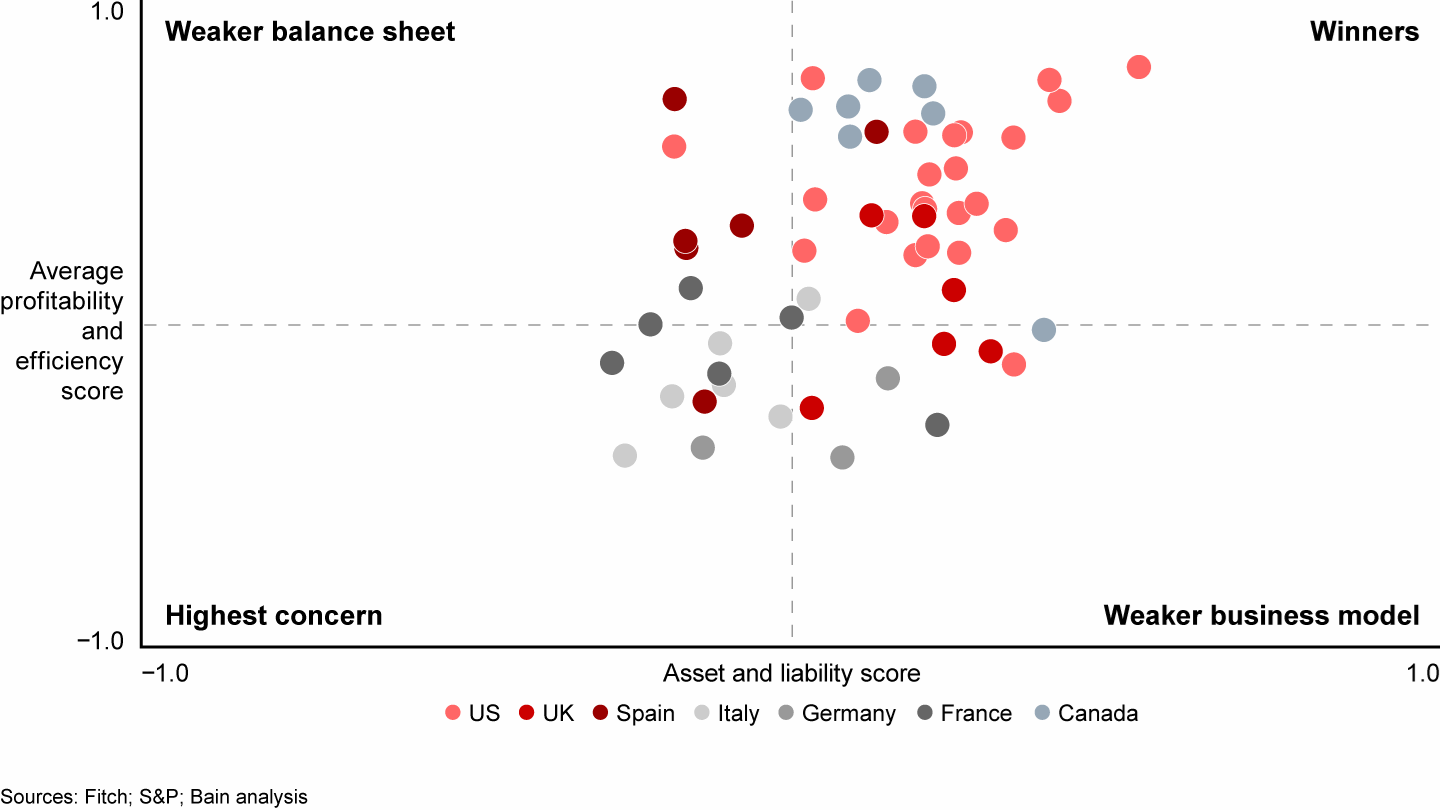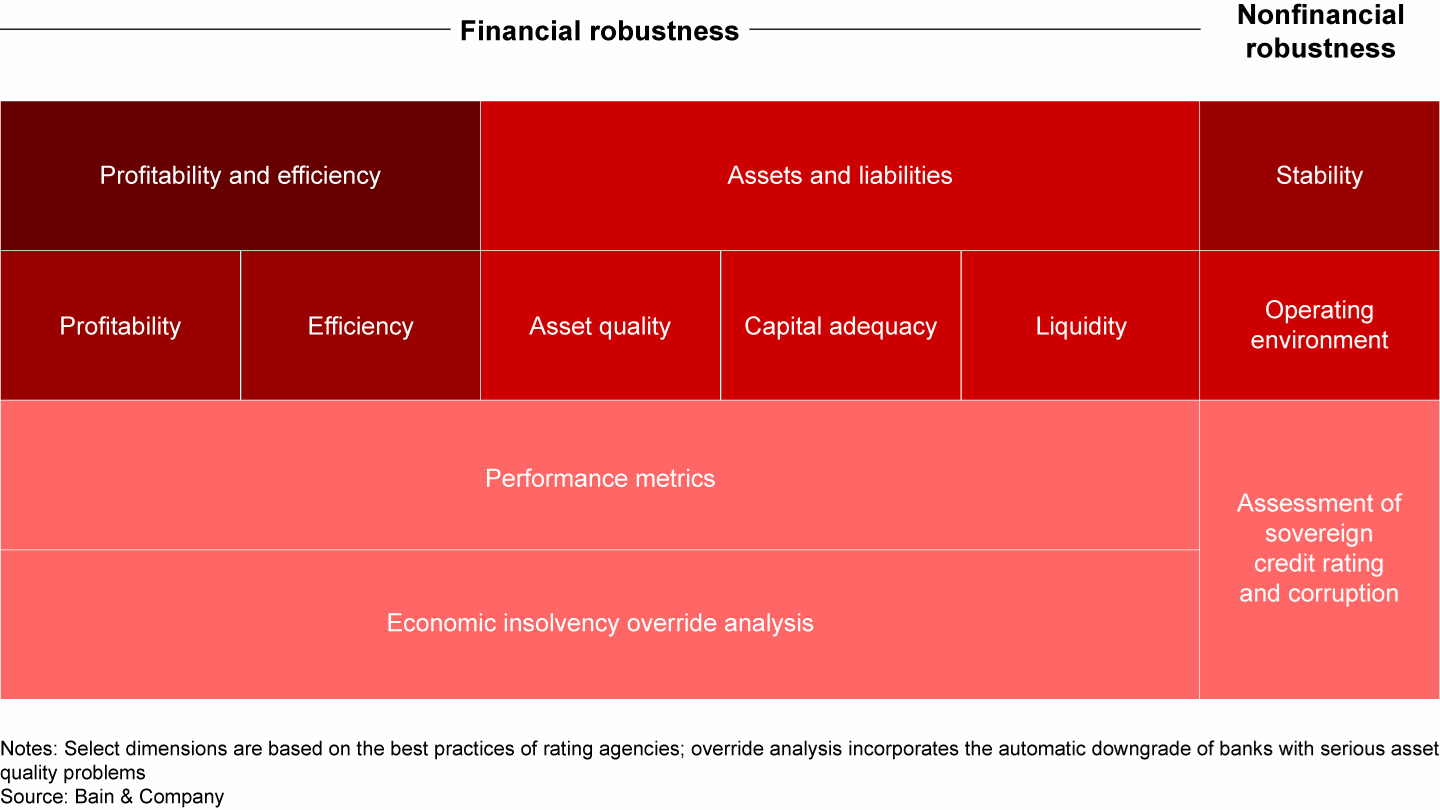論説

概要
- Bain’s latest health check of the banking system shows many European banks with weakened balance sheets and profitability over the past few years.
- North American and UK banks, by contrast, have held steady.
- Banks’ decay stems from the generally sparse innovation and productivity growth throughout Europe, which have narrowed the field of high-growth companies worthy of lending.
- Amidst the new shocks to the economy, many European banks should entertain moves such as consolidation and building growth in non-interest fee income.
Many European banks, hobbled by several years of sluggish economic growth and the Covid-19 pandemic, find themselves ill-prepared to handle new economic shocks. Their financial health has been declining over the past few years, in contrast to most North American and UK banks. They desperately need to restore growth and healthier balance sheets through consolidation, new fee income streams, and other measures.
These conclusions emerge from Bain & Company’s latest health check of the banking system, covering 636 banks across North America and Europe as of year-end 2021. Our health check scoring model derives from three dimensions, two of which represent banks’ robustness (see “How the scoring model works,” below):
- profitability and efficiency;
- asset and liability health (here, we give a relatively heavy weighting to asset quality as essential for future earnings); and
- stability of the operating environment.
Our scoring relies on data from Fitch Ratings and S&P Global Market Intelligence. The health check provides a uniquely integrated view, which stands in contrast to looking only at a balance sheet or income statement. Based on the combination of critical financial ratios, we calculate a score for each bank and place it in one of four categories: winners, weaker business model, weaker balance sheet, and highest concern.
US and Canadian banks, for the most part, remain in the winners’ quadrant, as they have in recent years. By contrast, banks in the largest eurozone economies of Germany, France, Italy, and, to a lesser extent, Spain have been struggling (see Figure 1). Return on equity in Europe, at an average 8.9% for 2021, was well below the 13.1 % seen in North America.
European banks have declined while the US, Canada, and the UK held steady on profitability, with improvements in asset quality


Some Spanish banks performed better in profitability than other developed markets in Europe. That reflects Spanish banks’ heavier exposure to South America, where non-mortgage consumer lending—an exceptionally volatile but profitable business over the past few years—is an outsize business relative to European economies.
Among individual European banks, there’s a lot of heterogeneity in performance (see Figure 2). Yet all four of these European countries have overall positions with lower-resilience balance sheets. Many banks in France and Italy slipped from the “weaker balance sheet” to the “highest concern” position. In Germany, more banks have degraded from “weaker business model” to “highest concern,” primarily because of problematic loans. They also struggle with revenue growth, especially non-interest income from corporate and investment banking as well as asset and wealth management businesses.
US and Canadian banks cluster among the winners while banks in large eurozone countries show more heterogeneity in performance


Banks’ decay stems from the generally sparse innovation and productivity growth throughout Europe, which have narrowed the field of high-growth companies worthy of lending.
While not reflected in this 2021 data, Russia’s war on Ukraine and the recent surge of inflation have exacerbated the challenge for large European banks with high exposure to Russia, coming hard on the heels of deteriorating asset quality and profitability through the Covid pandemic.
Turning to North America, most banks there improved performance in asset quality and held steady in profitability since 2018. This reflects the release of excess provisions made during Covid-19, as well as better liquidity scores, mainly due to the huge influx of deposits.
Looking ahead, as interest rates rise, the spread on mortgages and consumer lending will improve for banks. However, after the sugar rush of Covid-19 spending, consumers may get overstretched if a recession hits, raising the risk of nonperforming loans and other write-offs. In addition, European banks look set to become even more fragile given the widespread energy challenges caused by Russia’s attack.
If a bank aims to improve its health, it will look to improve both profitability and its balance sheet. Given the macroeconomic context and the current position of most European banks, they should consider the following moves to improve profitability.
- Reduce the cost base. Assess the bank’s cost structure and set ambitious targets for reductions, then adjust operations to reach the targets.
- Accelerate digital initiatives. With the customer experience at the heart of any initiative, simplify products and streamline processes to make digital more appealing.
- Renew the focus on growth. In recessionary times, it pays to ramp up asset-light businesses that generate fees, such as wealth management. The profit engine needs to be primed to bring in money when the ability to lend gets constricted.
Of course, over a period of time, improved profitability can lead to a healthier balance sheet, as a bank can reinvest profits in the balance sheet. In addition, banks should consider the following steps.
- Adjust the strategy. Adjust the portfolio, risk appetite, and location footprint to respond to current geopolitical risks.
- Consolidate. Mergers and acquisitions can help a weaker bank take advantage of the stronger bank’s capital position to improve both profitability and the balance sheet. M&As allow banks to gain scale, divest nonperforming loans, and reduce the cost to serve more customers. Governments may also insist on selective consolidation in order for banks to gain public assistance that will stave off failure. Regulators themselves—in particular the European Central Bank—are stakeholders who will want to create favorable conditions of consolidation within and beyond country borders.
No one can predict the duration and outcomes of pandemic variants or Russia’s war. But even if they were to end soon, most banks in Europe face hard choices to ensure that they survive, much less thrive. Should government bailouts return, they won’t extend to every incumbent, and should economies eventually recover, they won’t serve as a rising tide to lift all boats. Only major steps, ranging from consolidation to building profitable revenue streams, can help Europe’s decaying banks.
How the scoring model works
The scoring model in Bain’s health check of the banking system gathers data in six areas, with the heaviest weighting on asset quality (see Figure 3).
Bain’s scoring model provides a uniquely integrated view


Profitability. The key determinant of sustainable success or failure, profitability measures the ability to create economic value and to preserve or improve risk protection for creditors. Performance metrics include net income as a percentage of average total equity and net income as a percentage of average tangible equity.
Efficiency. Cost containment is a strategic focal point; it allows banks to satisfy stakeholders’ requirements without overly aggressive risk-taking. Performance metrics include operating expenses as a percentage of net revenue.
Asset quality. A main factor in future earnings and capital generation or erosion, loan quality is a key to determining a bank’s stability. Nonperforming loans predict future losses. Performance metrics as a percentage of gross loans include problem loans, loan-loss provisions, and corporate loans.
Capital adequacy. Banks typically fail due to losses in the loan portfolio, poor business models, or fraud—all of which lead to a decline in capital. In the case of low profitability, capital is the most important buffer for absorbing risk costs. Performance metrics include tier-1 capital as a percentage of risk-weighted assets, tangible common equity as a percentage of average risk-weighted assets, tier 1 capital as a percentage of total assets, and tangible common equity as a percent of average total assets.
Liquidity. Illiquidity is often a proximate cause of failure as banks might no longer be able to finance themselves under pressure. Access to market funding may not be based on long-term relationships but rather on creditworthiness. Performance metrics include gross loans as a percentage of total deposits and total debt—that is, liquid assets as a percentage of total assets.
Operating environment. Bank performance is often constrained by violent economic cycles, adverse political decisions, or weak legal systems. Declines in economic growth correlate highly with worsening asset quality. Performance metrics include the assessment of sovereign credit rating and corruption.